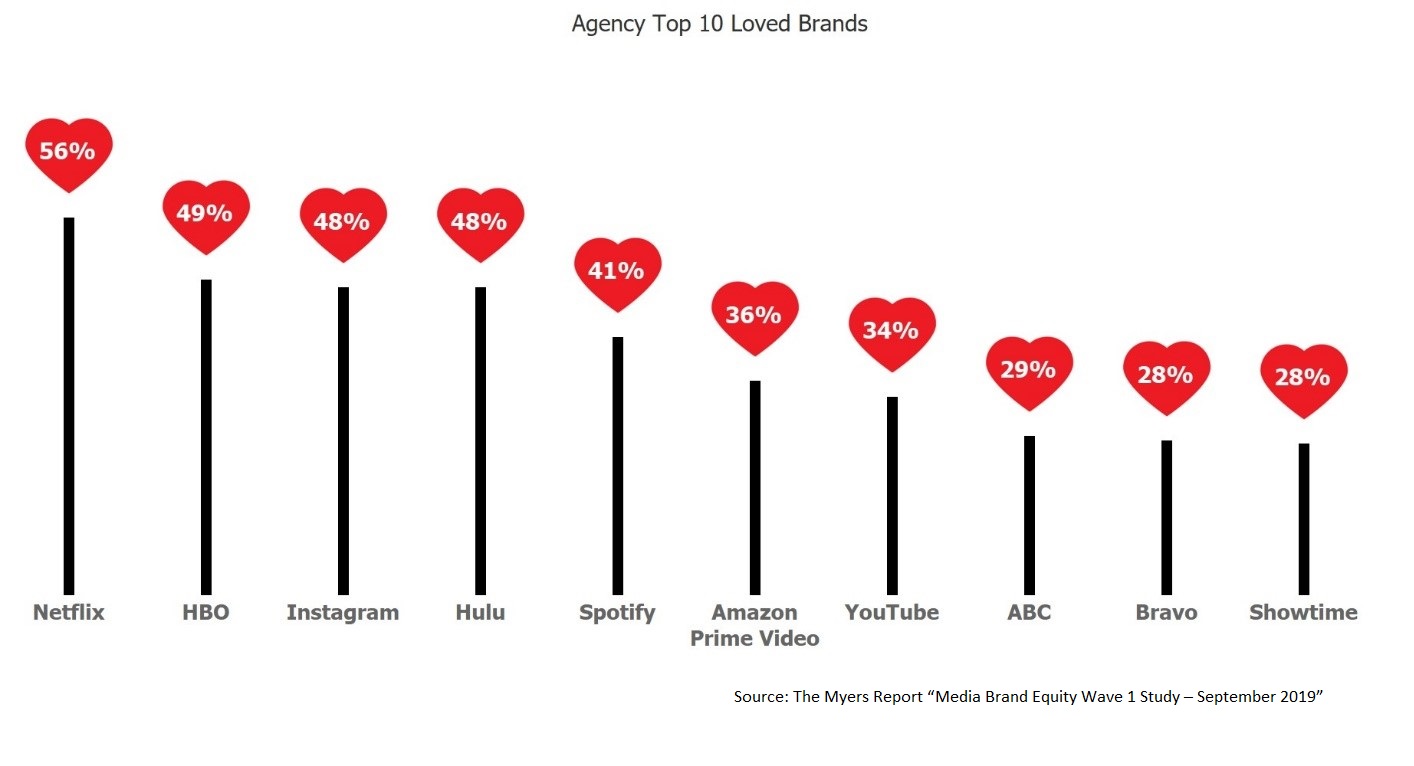What’s Love Got to Do With It?

Oh, love. Sweet love. It’s what the world needs now (and, seriously, it does!). And, when it comes to media brands, many of them are feeling the love from consumers — a deep love that keeps them together, forever. But, as for the most-loved media brand … well, that might surprise you.
“The Myers Report Brand Equity Study – Wave 1, 2019” is in and there’s a twist. The findings reveal the most beloved media brand across three cohorts: advertisers, agencies, and consumers. The top choice was one with no advertising. Shocked? Read on to learn which media brand garnered that honor, and for more surprises.
The Myers Report, in partnership with research platform Synqrinus, recently completed a sweeping study, rating the brand equity of major media brands. We queried more than 300 advertisers, 300 agencies, and 600 consumers about their feelings on 100 media brands — regarding their personal media consumption habits. We examined several elements of brand equity, including intensity of emotion, perception of social activism, cultural relevance, content differentiation, perceived ability to thrive in the future, and overall interest in the content. We found that advertisers and media professionals are not immune to their personal media consumption biases spilling over into their work.
That reaction is no surprise. Emotion is incredibly powerful and is core to what it means to be human. In particular, media — as both a reflection and driver of culture — embeds itself into our everyday decision making, whether direct or subconsciously. The current state of reporting and data on media consumption is still unclear, especially when it comes to single-viewer cross-platform data mixed with multi-viewer platform data (e.g., traditional television and digital video, place-based advertising). So, we set out to determine if agencies, advertisers, and consumers were aligned in their emotional investment in media companies. They are not.
In terms of emotional intensity, respondents were presented with 100 media brands and given the option to select “love,” “like,” “dislike,” or “don’t know” to signify their feelings on those brands. We found numerous differences, not only among the three cohorts, but also with subsets based on gender, age, and region.
It’s eye-opening that even top media buyers and marketers whose livelihood is predicated on effective and impactful communication with consumers — and whose charge is advertising and media placement — rate Netflix as their most loved media brand. Not only does Netflix not currently accept advertising, but it also has gone out of its way to deny rumors that it will eventually cave and start taking ads. In an extremely pointed statement to investors in its Q2 2019 earnings announcement, Netflix said, “We, like HBO, are advertising-free. That remains a deep part of our brand proposition. When you read speculation that we are moving into selling advertising, be confident that this is false. We believe we will have a more valuable business in the long term by staying out of competing for ad revenue and, instead, entirely focusing on competing for viewer satisfaction.”
There may not be ad placements, but there are plenty of marketing opportunities with Netflix. The latest season of Stranger Things, which launched this past July, had several marketing partnerships — in particular, Coca Cola and Baskin Robbins — that successfully blurred the line between branded entertainment and offline promotion, even daring to bring back “New Coke” in a hip, but ironic fashion so well-suited to Gen Z.
So, who ranked Netflix as their most beloved media brand? Seventy-four percent of advertisers, 56 percent of agency executives, and 55 percent of consumers truly love Netflix. But Netflix isn’t alone: five of the top 10 most-loved media brands (Netflix, HBO, Hulu, Spotify, and Amazon Prime Video) for agency respondents either have no advertising or limited advertising inventory available.

They say that love is blind. Perhaps those amorous Netflix fans are too much in love to see the brand for where it could be headed versus where it’s been.
Netflix faces major challenges over the next year and beyond. The release of several new streaming video-on-demand (SVOD) services (e.g., AppleTV+, Disney+, HBOMax, NBCU) brings Netflix its first real competition aside from Amazon Prime Video. As a consequence, Netflix has lost or may soon lose some top-viewed programming, including Star Wars, Avengers, Friends, and The Office. Additionally, the days of writing blank checks for originals is reportedly coming to an end, with Netflix’s head of content looking far more closely at the cost-effectiveness of big-budget productions.
Despite all that, “The Myers Report Brand Equity Report – Wave 1, 2019” finds that advertisers, agencies, and consumers are optimistic about Netflix’s long-term viability. A full 95 percent of advertisers, 98 percent of agency respondents, and 94 percent of consumers agree that Netflix will thrive in the future. We look forward to tracking this data over the next few months to see what, if any, changes occur as SVOD services further proliferate.
Photo credit: Tyler Nix / Unsplash
Click the social buttons to share this story with your friends and colleagues.
The opinions and points of view expressed in this content are exclusively the views of the author and/or subject(s) and do not necessarily represent the views of MediaVillage.com/MyersBizNet, Inc. management or associated writers.


